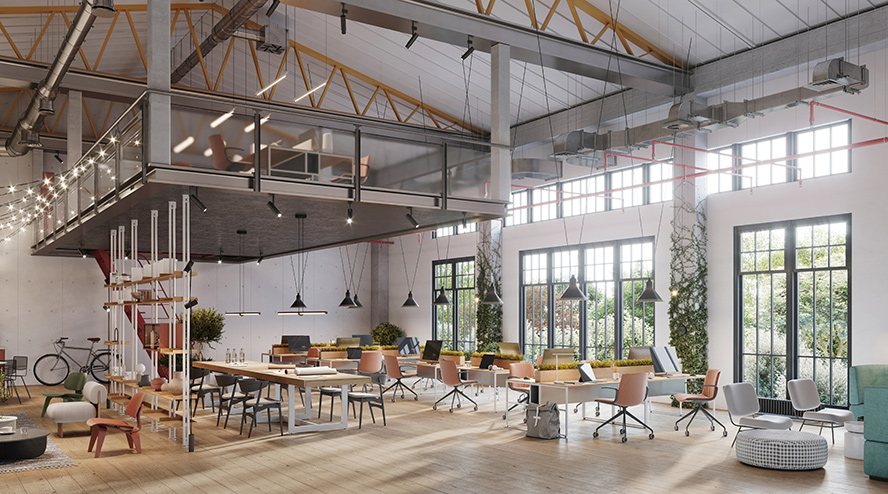Demand for flexible office space (flex) is recovering driven by corporates looking to adapt to the new world of work, as well as individuals seeking a refuge outside of working from home. We anticipate demand for flex to remain strong, especially in an environment of ongoing structural changes and cyclical uncertainties. In this article we explore which cities globally are likely to see the highest rise in occupier demand for flex space.
What drives demand for flex?
In 2018 flexible office take-up by providers accounted on average for about 8% of total office absorption across the 19 global markets that we monitor. Covid-19 came to disrupt this trend, as people’s homes became their workplaces for an extended period of time. In 2021 we saw flexible operators begin taking new spaces again, with flex office take-up accounting for 5% of the total last year.
Since the end of 2021 the negative trend has been gradually reversing as operators begin securing new sites for expansion. Demand for flex is now fuelled by a wide range of different businesses, both in terms of sector and size.
Occupiers and landlords drive expansion
This resurgence of demand is evident in the increased occupancy levels, which have, on average, rebounded to the levels seen pre-pandemic. According to the latest Flexmark* survey by Workthere, this has been reflected both in private office and in shared space occupancy, which have increased from 68.1% to 81.2% and 55.7% to 69% respectively.
Demand for space that meets emerging environmental criteria is another key driver for flex, as many cities, particularly in Europe, have made large commitments to reducing energy emissions. EPC deadlines are approaching in markets such as the Netherlands and the UK. Tenants who do not comply with the regulatory criteria, and cannot find high quality accommodation may opt for flexible office space.
A common misconception is that this type of office structure is just for technology occupiers. “We are experiencing a significant increase in demand for space from legal, financial and pharmaceutical organisations who are following in the footsteps of their tech counterparts” says Cal Lee, Founder and Global Head of Workthere. The average size of companies is also rising with corporates and large scale ups accounting for a bigger proportion of flex. According to Flexmark in the first half of 2022 they accounted for 42% of global flexible office occupiers, compared with 37% last year.
Landlords are also acknowledging the value of flexibility. Given the capital that is required to setup a flexible office, many providers look to partner with landlords to reduce their risk, while landlords are able to achieve rental income at a premium to the market rate if spaces are successful. Besides, several landlords have also converted their space into serviced offices offered on shorter/flexible lease terms as a response to rising occupier demand.

Identifying the global growth markets for flex space
We have selected 19 major global office markets and analysed the key factors that are likely to drive flex demand in the coming years. We focused on factors that determine how innovative and attractive to talent they are, such as VC investment, education and attitude towards flexible working. We also compared their office market characteristics such as demand and supply dynamics, traditional lease lengths and future service sector growth projections. Whilst we expect the trend to be positive across the cities of our index, the top cities are the ones that are likely to witness the highest demand for flex in the coming years.
Note: Cities ranked by innovation and talent attraction, office demand and supply dynamics, and future service sector growth projections
At the top of the index we have London (1st), Mumbai (2nd), Amsterdam (3rd) New York (4th) and Paris (5th). London, New York and Paris are cities where the concept of flexible offices had emerged and expanded in the years following the global financial crisis and the rise of the gig economy. The economies of these cities are driven by innovation, and they all have an established business culture geared towards flexibility. In addition, they are amongst the most expensive markets in the world in terms of office costs, with London and the US markets also characterised by long leases (10 years on average).
Mumbai, in second place, has a fast growing service sector and an active start-up scene. Local operators are particularly active and companies tend to commit for longer periods to flexible office space as they are accustomed to long leases.
Amsterdam ranks third. Despite its small size it has a large proportion of office based employment, flexible business culture and relatively high levels of VC investment. The share of office take-up by flex operators last year was the third highest in our index at 10% vs 9% pre-pandemic and activity levels have been sustained also during the first half of 2022.
In terms of Asian cities beyond Mumbai, Shanghai ranks 7th, followed by Ho Chi Min (8th) and Tokyo (12th). Ho Chi Min and Tokyo saw an increase in the share of flexible office take-up last year vs 2018, reflecting the growth dynamics of the sector in these cities.
Finally, Frankfurt, Warsaw and Barcelona rank 9th, 10th and 11th respectively. We expect demand for flex to rise in these smaller European markets for a number of reasons. Frankfurt scores highly in terms office based employment driven by the financial sector, innovation and flexible work culture. Warsaw, on the other hand, is a market that due to its competitive labour and property costs and skilled workforce has attracted major international companies. It is becoming a regional hub of innovation with VC investment almost tripling between 2020 and 2021. Barcelona is also acknowledged as an innovative city; VC investment has been steadily rising over the past five years.
Cal Lee comments: “We are seeing a clear flight to quality in many of our global markets from businesses seeking flexible space. This index points to the markets where there is most opportunity for further growth and it is no surprise to see the large metropolis of London, New York and Paris in the top five, however it is positive to see growing markets such as Mumbai, Amsterdam and Warsaw all make the list.”



